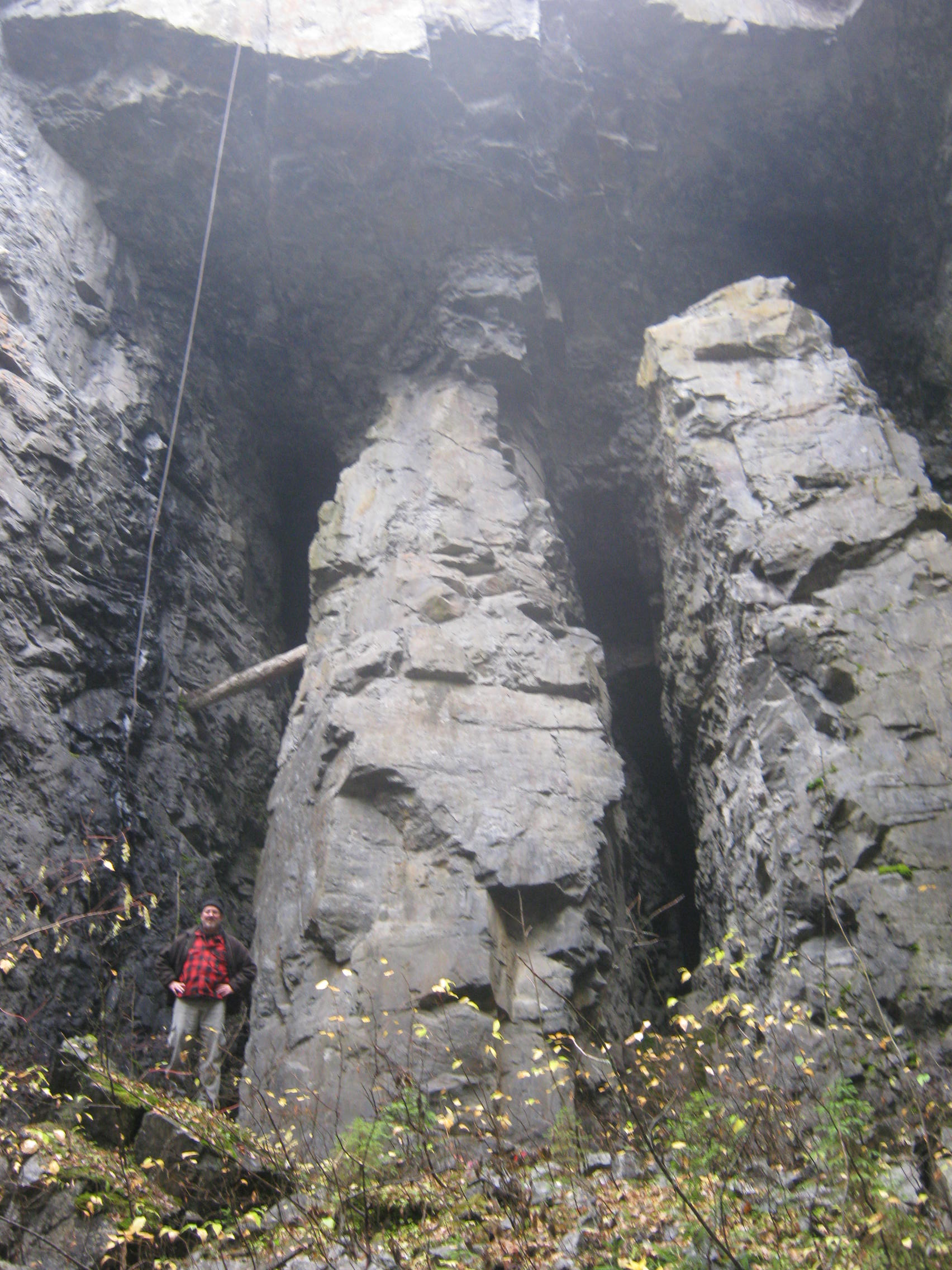There are several lessons to be learned in Cobalt. One of them is never try to climb the Devil’s Rock after an evening at the Miner’s Tavern. Another would be to make sure someone knows that you’re going for a hike into one of the many silver mining areas around the town; there are shafts everywhere and not all of them are fenced off. You can easily disappear in Cobalt.
Silver Boom & Bust
Cobalt has a unique gothic landscape; cliffs and cuts carved out from silver mining snake through the town and surrounding hills. At one time the skyline was dotted with head frames (the buildings used to haul out the silver), and the vista looked medieval and menacing. Cobalt was once more famous and bigger than Toronto, as prospectors rushed there to flush out silver from the beginning of the 20th century until the 1950s.
Along with the carved up landscape are remnants from the mining boom—streetcar tracks in the middle of a forest, lunar-like dust from tailings, and ruins from mining operations that could pass for the background in a Harry Potter movie. On one trip, we ran into astro-physicists who were looking at the fossils in the rock exposed from the mining so they could better understand what they were finding on Mars. That’s the kind of thing that happens in Cobalt.
 We’ve been to Cobalt in every season. Summer is the best time to climb the Devil’s Rock; a shear cliff face 300 feet high on the shore of Lake Temiskaming. The view is pretty incredible once you get up there. It’s a challenging hike but it’s probably easier if you didn’t spend the previous night drinking beer at the Miner’s Tavern. Not that I speak from experience. One of the more intriguing stories about the Rock is that loggers simply tossed the trees over the edge of the cliff so that they would float down to Ottawa via the Ottawa River.
We’ve been to Cobalt in every season. Summer is the best time to climb the Devil’s Rock; a shear cliff face 300 feet high on the shore of Lake Temiskaming. The view is pretty incredible once you get up there. It’s a challenging hike but it’s probably easier if you didn’t spend the previous night drinking beer at the Miner’s Tavern. Not that I speak from experience. One of the more intriguing stories about the Rock is that loggers simply tossed the trees over the edge of the cliff so that they would float down to Ottawa via the Ottawa River.
The fall is a better time to explore the mines because the diminished foliage makes it easier to see more. Also, it’s just creepier and more suited to Cobalt’s gothic vibe. One of the largest spent operations is in the centre of the downtown. This enormous canyon is fenced off so you kind of need a local to show you around. It’s essentially several stories down with tunnels (including one with what seems like a lake) everywhere and piles of rock the size of a house; it’s a complete apocalyptic setting just inches from people’s backyards. The day we were taken there our local guides were recounting how many people have ended up hospitalized by accidentally falling into it while inebriated. This is not a place you want to have a cocktail prior to visiting.
A Legacy of Resource Extraction
While looking around I couldn’t help but think about these huge resource extraction sites in Ontario. While most of them that are still operating or dangerous are under lock and key, the abandoned ones make for very interesting walks. Cobalt shows signs of neglect for sure, as once the silver was gone much of the fanfare or reason for the town’s existence also disappeared.
In recent years the town created an excellent walking tour for the abandoned silver mining sites—when I first visited Cobalt seven years ago this tour was looked after, the signs were clean, the trails cleared. Today, unfortunately, there doesn’t seem to be anyone taking care of this unique tour of Ontario history. These former resource-based places those that still show man-made markings on the landscape are an excellent reminder of our impact on the wilderness.
After time spent in northern England where communities lived cheek to jowl with coal mining, I realized that in Canada we hide our resources from people because we can. This disconnects us with our heritage and places like Cobalt that show the impact we have had on the landscape, for better or for worse. A silver spoon takes on a new meaning when you see the remnants of a pristine forest destroyed to create it.
Sights & Sounds of Cobalt
But back on the subject of cocktails, there is no point in going to Cobalt without visiting the Miner’s Tavern. Along with Classic Theatre Cobalt which has programming throughout the year and is a very bright light in the town, the Tavern is highly recommended. With a perfect balance of kitsch and Northern Ontario mining paraphernalia, the Tavern has become a hub for the community.
Live music, karaoke, bingo afternoons, fundraisers, special events of all kinds, and rockin’ Canada Day celebrations have made it a very special place. Even the local MP Charlie Angus straps on a guitar once in a while to play some his own songs. It’s also the best place to meet people who know Cobalt inside and out. The Tavern is actually one of the reasons we kept going back to Cobalt—the main reason being the research we were doing for paintings but the other was for the people. You will always get a friendly hello at the Tavern and hear lots of wonderful stories about the town because Cobalt is one of the more storied places in Ontario, well worth the detour up the 11B.






